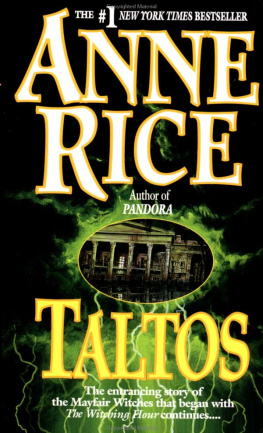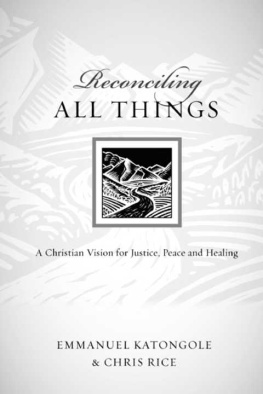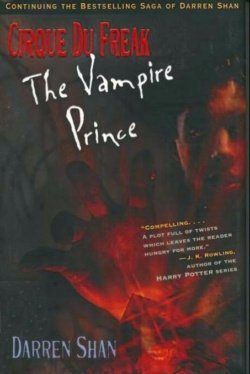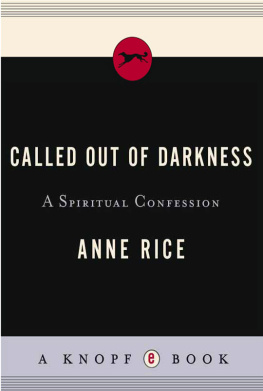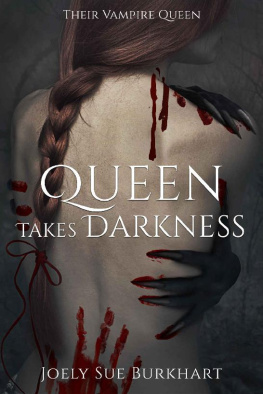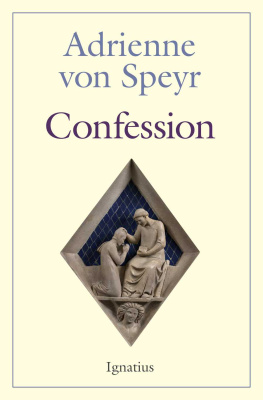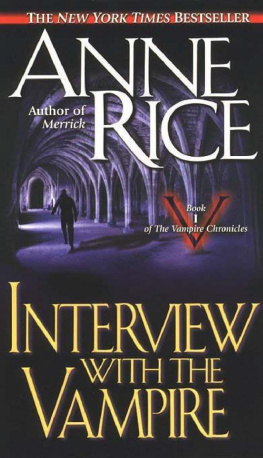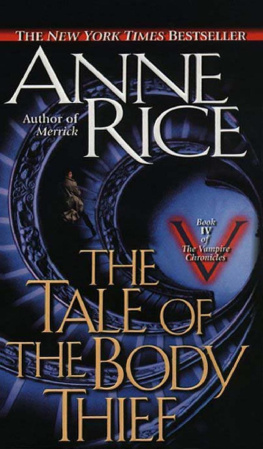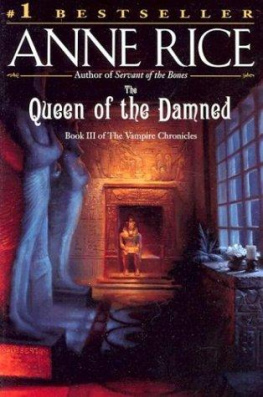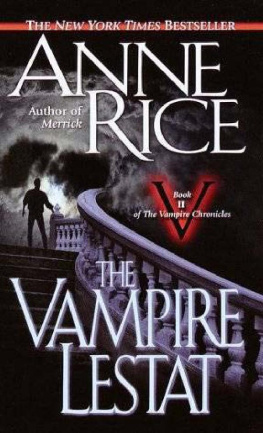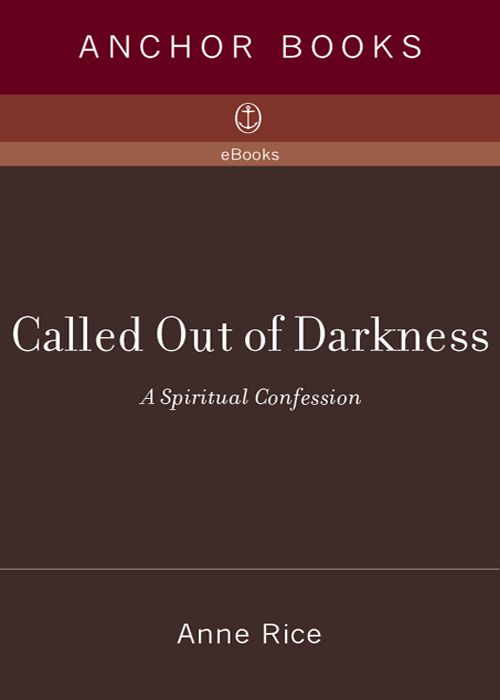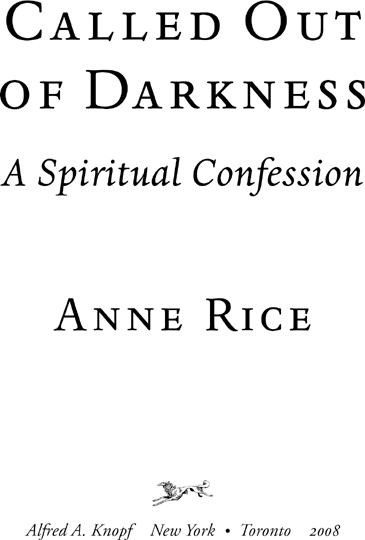ALSO BY ANNE RICE
Christ the Lord: The Road to Cana
Christ the Lord: Out of Egypt
Blood Canticle
Blackwood Farm
Blood and Gold
Merrick
Vittorio, The Vampire
The Vampire Armand
Pandora
Violin
Servant of the Bones
Memnoch the Devil
Taltos
Lasher
The Tale of the Body Thief
The Witching Hour
The Mummy
The Queen of the Damned
The Vampire Lestat
Cry to Heaven
The Feast of All Saints
Interview with the Vampire
F OR
The boys of
the Redemptorist Seminary
of Kirkwood
including
my father
Howard James OBrien
Out of the depths have I cried unto thee, O LORD.
Lord, hear my voice: let thine ears be attentive to the voice of my supplications.
If thou, LORD, shouldst mark iniquities, O Lord, who shall stand?
But there is forgiveness with thee, that thou mayest be feared.
I wait for the LORD, my soul doth wait, and in his word do I hope.
My soul waiteth for the Lord more than they that watch for the morning: I say, more than they that watch for the morning.
From Psalm 130
The King James Version
1
T HIS BOOK IS ABOUT FAITH IN G OD .
For more than twenty centuries, Christianity has given us dazzling works of theology, yet it remains a religion in which the heart is absolutely essential to faith.
The appeal of Jesus Christ was first and foremost to the heart.
The man knocked on his back on the Road to Damascus experienced a transformation of the heart. St. Francis of Assisi, giving away all of his clothes as he turned to follow Christ, was reflecting a decision of the heart. Mother Teresa founded her world-famous order of nuns because of a decision of the heart.
The immensity of these figures finds an imperfect student in me, but not an inattentive one.
I want to tell, as simply as I canand nothing with me as a writer has ever really been simplethe story of how I made my decision of the heart.
So here is the story of one path to God.
The story has a happy ending because I have found the Transcendent God both intellectually and emotionally. And complete belief in Him and devotion to Him, no matter how interwoven with occasional fear and constant personal failure and imperfection, has become the true story of my life.
If this path to God is an illusion, then the story is worthless. If the path is real, then we have something here that may matter to you as well as to me.
2
B EFORE I CAN DESCRIBE how I returned to faith, at the age of fifty-seven, I want to describe how I learned about God as a child.
What strikes me now as most important about this experience is that it preceded reading books. Christians are People of the Book, and our religion is often described as a Religion of the Book. And for two thousand years, all that we believe has been handed down in texts.
But no doubt many children learned about God as I didfrom my mother and from the experience of church which had little or nothing directly to do with knowing how to read.
Over the years, I turned out to be a consistently poor reader, and I dont think I ever read a novel for pleasure until I was in the sixth grade. Even in my college years, I was a poor reader and, in fact, couldnt major in English because I could not read the amounts of Chaucer or Shakespeare assigned in the classes. I graduated with a bachelor of arts degree in political science, principally because I could understand the historic background I received for political ideas through good lectures.
I was twenty-seven before I began to make up an undergraduate degree in English, and thirty-one before I received a masters in English. Even then I read so slowly and poorly that I took my masters orals on three authors, Shakespeare, Virginia Woolf, and Ernest Hemingway, without having read all of their works. I couldnt possibly read all of their works.
The reason Im emphasizing this is because I believe that what we learn through reading is essentially different from what we learn in other ways. And my concept of God came through the spoken words of my mother, and also the intensely beautiful experiences I had in church.
Its important to stress here that my earliest experiences involved beauty; my strongest memories are of beautiful things I saw, things which evoked such profound feeling in me that I often felt pain.
In fact I remember my early childhood as full of beauty, and no ugly moment from that time has any reality for me. The beauty is the song of those days.
I vividly remember knowing about God, that He loved us, made us, took care of us, that we belonged to Him; and I remember loving Jesus as God; and praying to Him and to His Blessed Mother, the Virgin Mary, when I was very small.
I cant really associate any one image with Jesus because there were so many around me, from small highly sentimental holy pictures, which we treasured at home, to magnificent images of Jesus in St. Alphonsus Church.
Ill describe the church in a minute, as it takes considerable describing, but first I want to mention a small place where we went often to pray. This was the Chapel of Our Mother of Perpetual Help on Third and Prytania streets, a consecrated Catholic chapel with a tabernacle and an altar, in which Mass was celebrated every day. The chapel was a huge room inside an old Garden District mansion, set in spacious gardens, that was also a high school.
My mother had graduated from this high school many years before, and I recall going to a garden party on the grounds when I was a little child. The building itself was impressive, with a central doorway, floor-length windows on the front and on both sides, and colonnettes along the front porch that held up the porch above.
Much later in lifeduring the 1990swhen I was a well-known author, I actually bought this building, as it had tremendous meaning for me. Not only had my mother gone to school there, but my aunts and cousins had gone to school there as well. Some cousins had been married in the chapel. And my strongest religious memories were centered on this place. The story of that purchase and what it meant requires a book, and indeed I wrote a novel using the building as a key backdrop, but that is not my concern just now.
This is what it was like in the 1940s to go to the Chapel of Our Mother of Perpetual Help.
We left our house at St. Charles and Philip, and walked up the avenue, under the oaks, and almost always to the slow roar of the passing streetcars, and rumble of traffic, then crossed over into the Garden District, a very special neighborhood filled with immense Greek Revivalstyle homes, many of which had been built before the Civil War. This was an immediate plunge into a form of quiet, because though traffic did move steadily on Prytania Street, it was nothing as loud as the traffic of the avenue. The oaks were bigger and more ancient, and the enormous houses with their Corinthian or Doric columns were monuments in themselves. Everywhere there were flowers. Purple lantana and ice blue plumbago burst through the pickets of black iron fences, and beyond in the more groomed gardens grew the flowers I associated with rich people: multi-petaled camellias and gorgeously defined roses in black beds. It was fine to pick the soft fragrant lantana, and the bunches of plumbago. The finer flowers one left alone.


